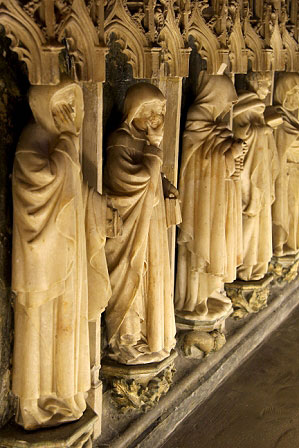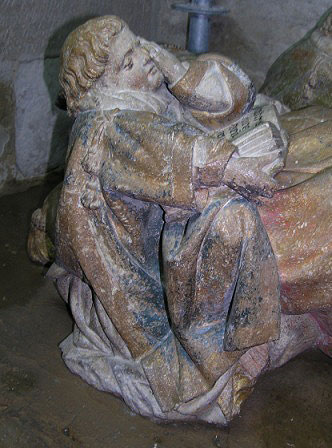25 May 2016
Gothic art in Navarre
Johan Lome and court sculpture in the times of Charles III and Blanche
Dr. Clara Fernández-Ladreda Aguadé
University of Navarra
Most of the works by Lome and his workshop are sepulchres, including the tomb of Charles III the Noble and his wife Eleanor of Castile, one of the finest examples of European funerary sculpture in the first half of the 15th century, begun at the end of 1413 and completed in mid-1419. Although it was directed by Lome, other craftsmen from the Southern Low Countries (Belgium), the Duchy of Burgundy and various parts of France were also involved in its construction, partnership.
It is a free-standing sepulchral bed tomb that combines sandstone - painted green with white veins, imitating marble - and alabaster - enriched with touches of colour and gilding, and with settings of semi-precious stones that are now lost.
The most important elements are the recumbent figures. That of the king wears the ceremonial attire he wore at his coronation - tunic, surcoat and mantle subjectsocq or soccus - and his head has traditionally been considered a portrait. The queen, on the other hand, is dressed in the fashion of the time - a very long skirt with a boat neckline, a tight-fitting surcoat with slits on the sides and enriched with a strip of gold work, and a snood also adorned with strips of gold work - and her face seems idealised. They are both wearing crowns. Above their heads are complex architectural canopies - a symbol of the celestial vault - and their feet rest respectively on a lion - a symbol of courage and strength - and a pair of dogs fighting over a bone - an allusion to human life gnawed by time.
The plorantes, who make up the funeral procession, complete the ensemble, made up of ecclesiastics - cardinals, bishops, canons and monks - and laymen. They can be grouped in pairs, who not only belong to the same social and religious category, but also present similar or complementary postures or gestures. Some have been depicted as portraits of historical figures, but this seems unlikely.

Sepulchre of Carlos III and Blanca
Pamplona Cathedral
Plorantes
Two sources of inspiration were combined in its construction: the tomb of Charles V King of France and his wife Joan of Bourbon, the work of André Beauneveu and Jean de Liège, and that of Philip the Bold, Duke of Burgundy, whose designwas basically the work of Claus Sluter, although Jean de Marville and Claus de Werve were also involved.
The royal sepulchre aroused the desire for emulation of prelates and nobles, and led to an explosion of monumental tombs, until then very rare in Navarre. However, none of them followed the formula of the free-standing sepulchral bed; instead, the simpler arcosolium was adopted. In addition, alabaster was abandoned.
Curiously, there are two tombs corresponding to the same personage, Sancho Sánchez de Oteiza. The first is in the then collegiate church of Tudela - today a cathedral - and was commissioned when he was its dean, while the second is in the Pamplona cathedral and was commissioned after his promotion to the episcopal see in 1420.
While the arcosolio in Tudela is very simple, the one in Pamplona is much more elaborate, being inspired by the window of the Cámara Luenga in the Old Palace of Olite. In those sculptures, the recumbent and the two deacons flanking it are practically reduced, while in this one the deacons have been replaced by angels and the funeral cortege has also been incorporated, possibly based on that of the tomb of his predecessor, Miguel Sánchez de Asiáin. contactIn both cases the recumbent figures are similar to those of Charles III, while their companions - deacons and angels - have references in the Burgundian sculpture of Sluter and Werve.

Tudela. Cathedral
Sepulchre of Sancho Sánchez de Oteiza. Detail
The tomb of Pere Arnaut de Garro and Juana de Beunza in the cloister of Pamplona Cathedral, which existed in 1422, stands out among the tombs of the nobility, as it is quotationin the knight's will.
The typology and the designare the same as those of the tomb of Don Sancho Sánchez de Oteiza in Pamplona Cathedral, but there are differences, such as the more advanced tracery and the presence of mural paintings. As for the recumbents, that of Pere Arnaut is similar to that of Charles III in the typology of the head, but the clothing is different, as he is dressed as befits a knight, with armour and huca, also wearing the chestnut-leaf necklace -emblem of the order of knighthood of the White Hound or of the Good Faith, founded by the monarch-, an attire copied in the other noble tombs. His wife's attire, based on a hopalanda and a horned headdress, is similar to that of the statue of Queen Blanca in Santa María de Olite. The ensemble is completed with a Calvary, several saints and a God the Father, presumably derived from contemporary Burgundian sculptures by Sluter and Werve.
The remaining noble tombs - belonging to St. Francis of Olite and St. Dominic of Estella - follow the modelof the previous ones, but simplified and of lesser quality.
This sectionis completed by funerary reliefs, represented by those of Enequo Pinel of San Pedro de Olite and Martín Cruzat of San Saturnino de Pamplona, a typology unknown in Navarre until now, but with a long tradition in Tournai, Lome's native town, so it can be assumed that it was a fashion introduced by him.
In addition to the tombs, Lome and his workshop made a series of doorways sponsored by the monarchy, as evidenced by the presence of their coats of arms.
The most important is the one in the north transept of Pamplona cathedral - better known as St Joseph's - whose tympanum bears a Coronation of the Virgin, possibly inspired by that of the portal of Saint Jacques in Liège - a town near Tournai - which should be related to the coronation of Queen Doña Blanca in 1429. Somewhat earlier, although of lesser size and quality, is that of the convent of San Francisco de Olite, executed when the sovereign was still an infanta, on whose tympanum the Calvary has been depicted. Slightly different is the one in the cloister of the Olite parish church of Santa María, documented in 1432, as it lacks a tympanum and the decoration is located in the spandrels, where there are statues of the queen and the Virgin, the patron saint of the church.
